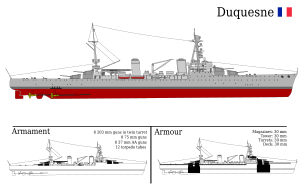Duquesne-class cruiser
 Duquesne in her 1939 configuration
| |
| Class overview | |
|---|---|
| Name | Duquesne |
| Preceded by | Duguay-Trouin class |
| Succeeded by | Suffren class |
| Built | 1924–1928 |
| In service | 1928–1950 |
| In commission | 1928–1950 |
| Completed | 2 |
| Retired | 2 |
| General characteristics | |
| Type | heavy cruiser |
| Displacement | list error: <br /> list (help) 10,000 tonnes (standard) 12,200 tons (full load) |
| Length | 191 m (627 ft) (627 feet) overall |
| Beam | 19 m (62 ft) (62 feet) |
| Draught | 6.32 m (20.7 ft) (20.75 feet) |
| Installed power | 120,000 horsepower (89,000 kW) |
| Propulsion | 4-shaft Rateau-Bretagne single-reduction geared turbines, 9 Guyot boilers |
| Speed | 33¾ knots |
| Range | 4,500 @ 15 knots (8,300 km @ 28 km/h) |
| Complement | 605 |
| Armament | list error: <br /> list (help) 8 203mm/50 Modèle 1924 guns (4 × 2) 8 75 mm anti-aircraft guns (8 × 1) 8 37 mm anti-aircraft guns (4 × 2) 12 13.2 mm AA (4 × 3) 12 550 mm (21.7 inch) torpedo tubes (4 × 3); |
| Armour | list error: <br /> list (help) magazine boxes 30 millimetres; deck 30 millimetres; turrets and tower, 30 millimetres. |
| Aircraft carried | 2 GL-812 (superseded by GL-832 then Loire-Nieuport 130, 1 catapult |
| Notes | [1] |
The Duquesne Class were the first class of post Washington Treaty heavy cruisers built for the French Navy. They have been criticised by naval architects for having very little armour and being lightly built.[1] However, they were considered to be good steamers and seaworthy vessels which could maintain 30 knots (35 mph) indefinitely at half power.[2]
Ships
- Duquesne - named after French Admiral Abraham Duquesne - built by Arsenal de Brest, laid down 30 October 1924, launched 17 December 1925, completed 25 January 1925. Paid off 1950. Scrapped 1955.[1]
- Tourville - named after French admiral Anne Hilarion de Tourville - built by Arsenal de Lorient, laid down 4 April 1925, launched 24 August 1926, completed 12 March 1929. Paid off 1950. Scrapped 1963.[1]
History
Duquesne spent the opening months of World War II assigned to one of the South Atlantic hunting groups searching for the pocket battleship Admiral Graf Spee, while Tourville searched for German ships in the Mediterranean Sea. Both ships were assigned to Force X in the Mediterranean following the Italian declaration of war, and were "demilitarized" in Alexandria harbor from 1940 through mid-1943. Both were then refitted in the United States, landing their torpedo tubes, catapults and aircraft, and being given an augmented anti-aircraft armament of eight Bofors 40 mm guns and sixteen Oerlikon 20 mm cannon.[1] They patrolled the mid-Atlantic for Axis blockade runners; but their anti-aircraft protection was still considered inadequate to provide gunfire support for the invasion of Normandy. Duquesne was part of the French Naval Task Force formed in December 1944 to bombard pockets of German resistance on the French Atlantic coast; and both ships participated in the French reoccupation of French Indochina in 1946.[3]
-
Duquesne in original anti-surface layout
-
Tourville after refit: reinforced anti-air armament, removal of sea plane, torpedo launchers and aft mast
-
Tourville in 1929
See also
![]() Media related to Duquesne class cruisers at Wikimedia Commons
Media related to Duquesne class cruisers at Wikimedia Commons
References
- Auphan, Paul; Mordal, Jacques (1959). The French Navy in World War II. Westport, Connecticut: Greenwood Press.
{{cite book}}: Cite has empty unknown parameter:|coauthors=(help) - John Jordan, Duquesne and Tourville: The first French treaty cruisers in Warship 2005. Conway Maritime Press 2005. ISBN 1-84486-003-5
- le Masson, Henri (1969). Navies of the Second World War: The French Navy 1. Garden City, New York: Doubleday & Company.
{{cite book}}: Cite has empty unknown parameter:|coauthors=(help) - Anthony Preston - The World's Worst Warships. Conway Maritime Press (2002) ISBN 0-85177-754-6
- M J Whitley (1995). Cruisers of World War Two: An International Encyclopedia. London: Arms & Armour. ISBN 1-85409-225-1.
{{cite book}}: Cite has empty unknown parameter:|coauthors=(help)



